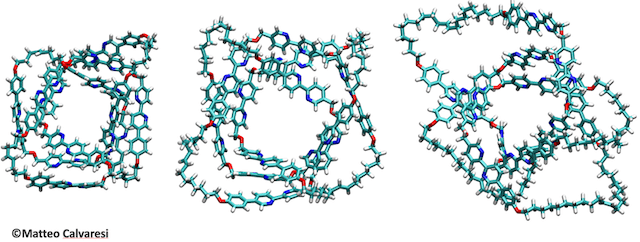Nano-nodi molecolari per i materiali del futuro / Nano-molecular nodes for the materials of the future
Nano-nodi molecolari per i materiali del futuro / Nano-molecular nodes for the materials of the future
Segnalato dal Dott. Giuseppe Cotellessa / Reported by Dr. Giuseppe Cotellessa

Per la prima volta, un team di ricercatori è riuscito a paragonare le caratteristiche di nano-nodi realizzati su catene molecolari di lunghezza diversa. Una scoperta che apre la strada a una nuova generazione di materiali, più leggeri, resistenti e flessibili
Lo sanno bene i marinai: quando si parla di nodi la lunghezza, tensione e tenuta sono fattori in grado di fare la differenza. E lo sanno bene anche i chimici, che spesso hanno a che fare con intrecci simili ma molto più piccoli, a livello molecolare. Se però è semplice confrontare e valutare nodi diversi nel mondo macroscopico, quando le dimensioni diventano nanometriche le cose si fanno molto più complicate.
Una soluzione ora grazie al lavoro di un gruppo di ricerca delle università di Bologna e di Manchester, che per la prima volta è riuscito a paragonare le caratteristiche di nano-nodi realizzati su catene molecolari di lunghezza diversa. I risultati dello studio, pubblicati su Pnas, aprono la strada a future applicazioni tecnologiche da cui potranno nascere materiali di nuova generazione, più leggeri, resistenti e flessibili.
Nodi nanometrici
La formazione di intrecci a livello molecolare è un fenomeno comune in natura, che si può osservare in biomolecole come le proteine o il DNA. Prendendo spunto proprio da queste strutture naturali, negli ultimi anni gli scienziati sono riusciti a sviluppare strategie per realizzare nano-nodi artificiali, intrecciando molecole ottenute per sintesi chimica e congiungendo le loro estremità.
“Questi presentano un’architettura che mostra diverse analogie con i nodi macroscopici”, spiega Matteo Calvaresi, che ha coordinato il gruppo di ricerca dell’Università di Bologna. “Ma se nella vita quotidiana è abbastanza facile rendersi conto di come la differente lunghezza di un nodo può influenzare la sua tenuta e le sue proprietà macrosopiche, quando si tratta di nano-nodi fare le stesse valutazioni non è così immediato”. Questo perché fino ad oggi non era possibile confrontare tra loro, a livello molecolare, nodi di diverse dimensioni, lunghezza e tenuta.
Tre nano-nodi a confronto
A riuscirci, per la prima volta è stato il gruppo di ricerca anglo-italiano guidato da David Leighdell’Università di Manchester, che già nel 2017 era entrato nel Guinness dei primati per aver realizzato il nodo molecolare più piccolo al mondo. Con questo nuovo studio, gli scienziati sono riusciti ad annodare allo stesso modo tre catene molecolari di tre lunghezze diverse: 20, 23 e 26 nanometri. Sono così nati tre nodi con la stessa forma ma legati su fili molecolari di dimensioni differenti, che i ricercatori hanno potuto mettere a confronto, evidenziandone le diverse caratteristiche.
“Confrontandoli”, ha spiegato Calvaresi, “abbiamo scoperto come la struttura, la dinamica e la reattività delle catene molecolari annodate variano sensibilmente in funzione della lunghezza e quindi della rigidità del nodo. L’esempio più evidente, in questo senso, è che i tre nodi, quando sottoposti a stress, presentano tre diversi punti di rottura”.

(Foto: Matteo Calvaresi, Università di Bologna)
Nanomateriali annodati
I ricercatori, quindi, sono riusciti a creare dei modelli capaci di spiegare come la dimensione dei nano-nodi riesce ad influenzare la loro tenuta e le loro proprietà chimico-fisiche: la diversa tensione degli intrecci e il diverso scorrimento del filo molecolare determina le differenti caratteristiche delle tre molecole. Un risultato che può rivelarsi particolarmente rilevante per l’ideazione di nuovi nanomateriali.
“Questo lavoro è di fondamentale importanza per la progettazione di materiali molecolari annodati: la scoperta delle proprietà che regolano i nano-nodi permetterà in futuro di intrecciare molecole in maniera tale da generare on demand una nuova generazione di materiali più leggeri, resistenti e flessibili”, ha concluso Calvaresi.
ENGLISH
For the first time, a team of researchers was able to compare the characteristics of nano-knots made on molecular chains of different lengths. A discovery that paves the way for a new generation of materials that are lighter, stronger and more flexible
Sailors know this well: when it comes to knots, length, tension and tightness are factors that make the difference. Chemists also know this well, often dealing with similar but much smaller plots at the molecular level. However, if it is easy to compare and evaluate different nodes in the macroscopic world, when the dimensions become nanometric, things become much more complicated.
A solution now thanks to the work of a research group of the universities of Bologna and Manchester, which for the first time managed to compare the characteristics of nano-nodes made on molecular chains of different lengths. The results of the study, published on Pnas, open the way for future technological applications from which new, lighter, resistant and flexible materials can be created.
Nanometric nodes
The formation of intertwining at the molecular level is a common phenomenon in nature, which can be observed in biomolecules such as proteins or DNA. Taking its cue from these natural structures, in recent years scientists have been able to develop strategies to achieve artificial nano-nodes, intertwining molecules obtained by chemical synthesis and joining their ends.
"These present an architecture that shows different similarities to macroscopic knots", explains Matteo Calvaresi, who coordinated the research group of the University of Bologna. "But if in everyday life it is easy enough to realize how the different length of a knot can affect its hold and its macrosopic properties, when it comes to nano-knots making the same evaluations is not so immediate". This is because up to now it was not possible to compare, at a molecular level, knots of different sizes, lengths and holdings.
Three nano-nodes compared
To do so, for the first time it was the Anglo-Italian research group led by David Leigh of the University of Manchester, which already in 2017 had entered the Guinness Book of Records for having created the smallest molecular node in the world. With this new study, scientists have managed to knot three molecular chains of three different lengths in the same way: 20, 23 and 26 nanometers. Thus three nodes were born with the same shape but linked to molecular threads of different sizes, which the researchers were able to compare, highlighting their different characteristics.
"Comparing them", Calvaresi explained, "we have discovered how the structure, the dynamics and the reactivity of the knotted molecular chains vary considerably depending on the length and therefore on the stiffness of the knot. The most evident example, in this sense, is that the three knots, when subjected to stress, present three different points of breaking ".
Knotted nanomaterials
The researchers, therefore, have succeeded in creating models capable of explaining how the size of the nano-nodes is able to influence their seal and their chemical-physical properties: the different tension of the weaves and the different sliding of the molecular wire determines the different characteristics of the three molecules. A result that may prove particularly relevant for the design of new nanomaterials.
"This work is of fundamental importance for the design of knotted molecular materials: the discovery of the properties that regulate nano-nodes will allow in the future to weave molecules in such a way as to generate on demand a new generation of lighter, resistant and flexible materials" , Calvaresi concluded.
Da:
https://www.galileonet.it/2019/01/nano-nodi-materiali-futuro/



Commenti
Posta un commento